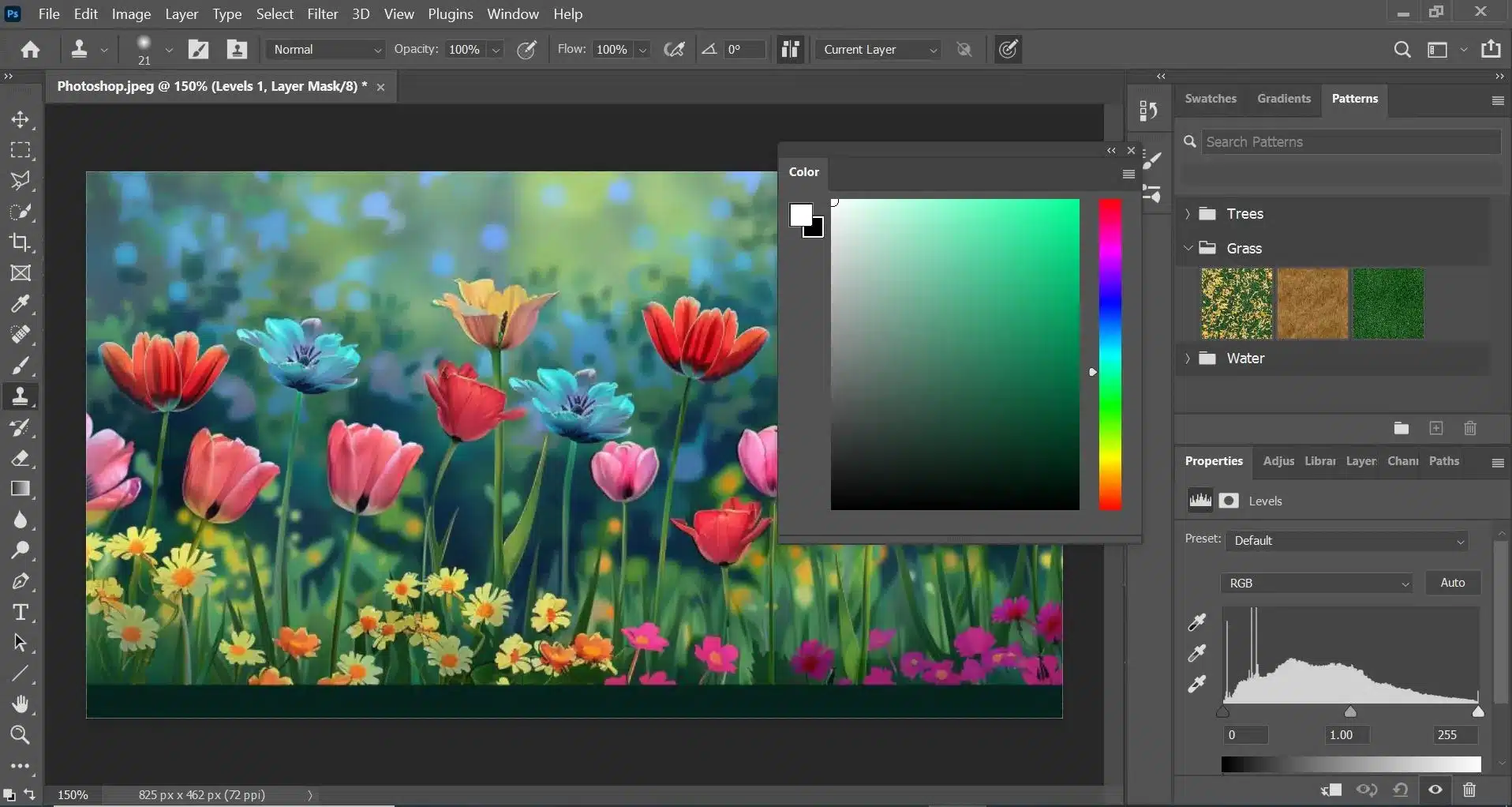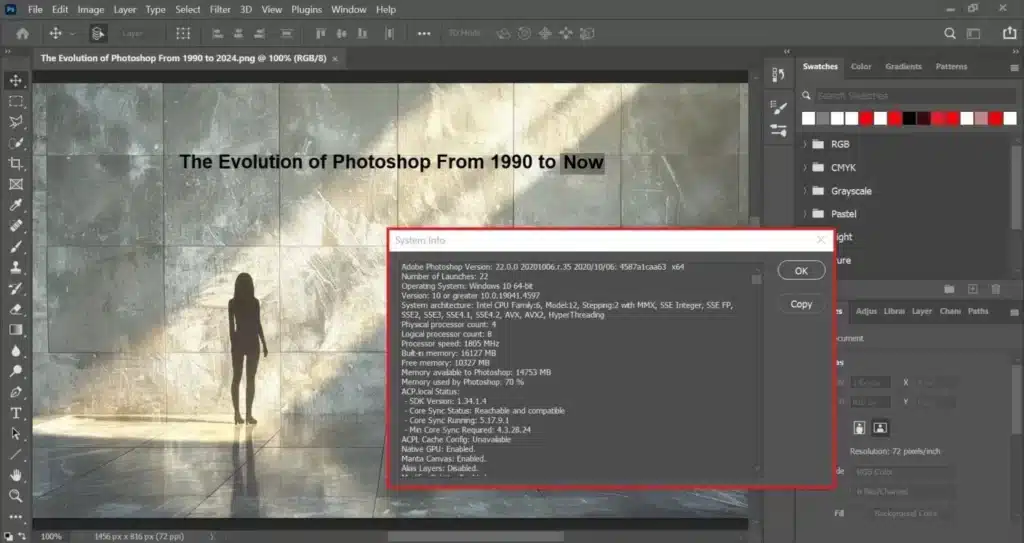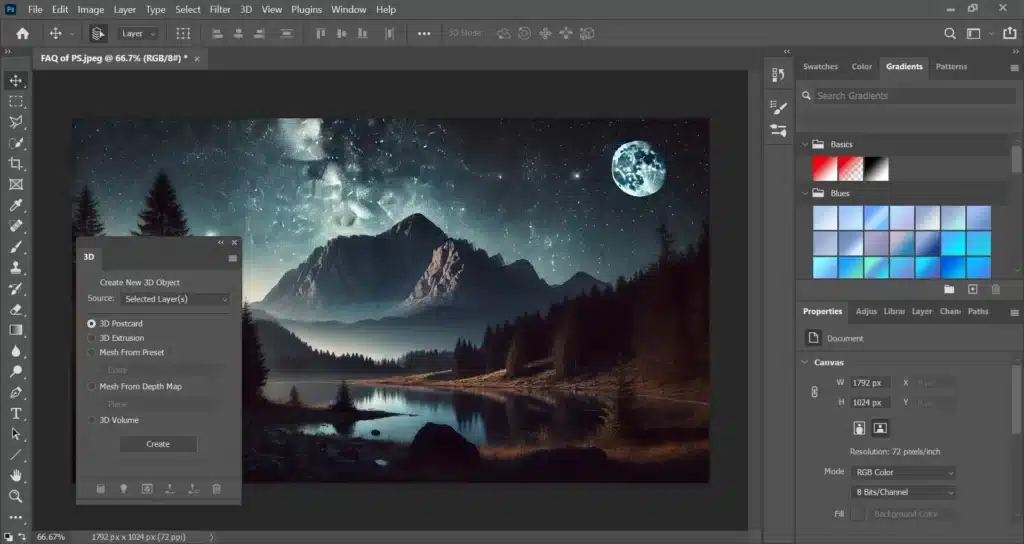
Introduction to Adobe Photoshop
For instance, consider a professional photographer who needs to perfect a client’s portrait. Using Photoshop, they can seamlessly remove blemishes, adjust lighting, and even remove background to create a flawless image. This capability not only enhances the photographer’s work quality but also saves time compared to traditional refining methods.
Table of Contents
The Evolution of Photoshop: From 1990 to Now

The Birth of Photoshop: 1990
Photoshop first emerged in 1990, created by Thomas and John Knoll. Initially, it was a simple program for displaying grayscale portraits on monochrome displays. Adobe recognized its potential and acquired the license, releasing the first version, Photoshop 1.0. This early version included basic aspects like crop, rotate, and adjust white balance, laying the foundation for future enhancements.
Major Milestones and Innovations: 1990-2010
Throughout the 1990s and early 2000s, Photoshop underwent significant transformations. Adobe introduced layers in Photoshop 3.0 in 1994, revolutionizing the way users edited portraits. The addition of attributes such as the History Palette in Photoshop 5.0 and the Healing Brush in Photoshop 7.0 further enhanced its capabilities. By the time Photoshop CS4 was released in 2008, it included advanced equipments like content-aware scaling and 3D modification.
Recent Advancements and Future Outlook: 2010 to Onward
The last decade has seen integrate more sophisticated characteristics, harnessing the power of AI and machine learning. Photoshop CC (Creative Cloud) launched in 2013, allowing users to access this via subscription and enabling seamless updates. The introduction of equipment like Select Subject and Content-Aware Fill Workspace showcased Adobe’s commitment to innovation. As of now, Adobe continues to push boundaries with enhanced AI capabilities, improving usability, and expanding mobile functionality.
Key Features and Tools in Adobe Photoshop
Layers and Masks
Tools in Photoshop, allowing users to work on different parts of an image without affecting others, include Layers and Masks. Layers enable stacking multiple images or elements, which can be edited independently. Masks, on the other hand, provide the ability to hide or reveal parts of a layer without permanently altering the image. This combination gives users unparalleled control over their modification process, making complex compositions manageable. Adobe Photoshop tutorials often highlight the use of Layers and Masks to help users master these essential tools in Adobe photo editing software.
Selection Tools
Photoshop offers a variety of selection tools, such as the Marquee, Lasso, and Magic Wand equipments, which help in isolating specific parts of an image for refining. The more recent addition, the Select Subject tool, utilizes AI to automatically select the main subject in an image with remarkable accuracy. Many Adobe Photoshop tutorials provide in-depth guidance on effectively using these selection tools within Adobe photo editing software. Moreover, these tools are essential for tasks like removing backgrounds, cutting out objects, and making precise adjustments to specific areas.
Adjustment Layers and Filters
Adjustment layers in Photoshop are non-destructive equipment that allow users to apply color and tonal adjustments to an image. These include options like Levels, Curves, and Hue/Saturation, which can be modified at any time without altering the original image. Additionally, Photoshop’s extensive range of filters, such as Gaussian Blur and Sharpen, provide various effects and enhancements, enabling users to fine-tune their images to perfection. Understanding how to use these both is a key focus in many Adobe Photoshop tutorials, making it easier for users to harness the full potential of Adobe photo editing software.
Key Features Comparison Table
| Feature | Description | Use Case | Example |
|---|---|---|---|
| Layers & Masks | Enables independent refining of image parts | Complex compositions | Combining multiple images seamlessly |
| Selection Tools | Tools for isolating specific image areas | Background removal | Cutting out objects |
| Adjustment Layers | Non-destructive color and tonal adjustments | Color correction | Enhancing image contrast |
| Filters | Range of effects and enhancements | Image refinement | Applying blur effects |
Photoshop for Creative Professionals
Graphic Designers
Graphic designers rely heavily on Photoshop for creating visually appealing designs. The app provides methods for manipulating images, creating custom graphics, and designing layouts for print and digital media, as highlighted in many Adobe Photoshop tutorials. Designers can easily add video elements to their projects, enhancing the overall presentation and making their designs more dynamic. This Adobe photo editing software has an extensive library of fonts, brushes, and shapes, allowing for limitless creativity and customization. The ability to work with RAW format and mask tools ensures precision in their designs.
Photographers
Photographers use Photoshop to enhance and retouch their portraits, ensuring each photo is perfect. The app offers advanced methods for color correction, exposure adjustments, and removing imperfections. Photographers can also add video clips to their slideshows and portfolios, providing a richer experience for their clients. With characteristics like batch processing, photographers can efficiently edit large volumes of snapshots, saving time and maintaining consistency. Integration with Abode Lightroom allows photographers to open and refine their RAW images seamlessly.
Digital Artists
Web Designers
Web designers use Photoshop to create mockups and prototypes for websites. The app’s ability to work with high-resolution images and create pixel-perfect designs is crucial for website design. Website designers can add video backgrounds and animations to their mockups, providing a clear vision of the final product. Photoshop’s integration with other Adobe apps, such as Dreamweaver, further streamlines the workflow from design to development. The support for Windows systems ensures compatibility across different platforms, and text styling help in designing website elements effectively.
Marketing Professionals
Marketing professionals use Photoshop to create engaging and persuasive visual content. The app enables them to design eye-catching advertisements, social media posts, and promotional materials. They can add video snippets to their marketing campaigns, enhancing engagement and reach. Many Adobe Photoshop tutorials provide insights into leveraging the software’s powerful equipments to ensure that all visual content aligns with the brand’s identity and messaging. The text modification capabilities and mask function help in creating visually consistent marketing materials.
Adobe Photoshop Versions and Updates
Photoshop 1.0: The Beginning
Photoshop 1.0 was released in 1990 and marked the start of a new era in digital image refining. Created by Thomas and John Knoll, it quickly gained popularity among photographers and graphic designers. The initial version provided basic tools like cropping, rotating, and adjusting color temperature, which laid the groundwork for the advancements we see today. Its simple yet effective interface set the stage for future enhancements.
Photoshop CS6: A Major Upgrade
Released in 2012, Photoshop CS6 introduced significant improvements that enhanced the user experience. It featured the Adobe Mercury Graphics Engine, which improved speed and performance, making it easier to handle large files and complex edits. The Content-Aware Patch tool was another notable addition, allowing users to move or extend objects in an image with ease. This version also brought a more modern and intuitive interface, which streamlined the workflow for professionals.
Photoshop CC: The Creative Cloud Revolution
Photoshop: Cutting-Edge Innovations
The most recent version of Photoshop introduced groundbreaking characteristics that leverage artificial intelligence and machine learning. These advancements include enhanced selection tools, sky replacement, and neural filters that allow for sophisticated edits with just a few clicks. Photoshop continues to push the boundaries of what is possible in digital image refining, ensuring that it remains the go-to tool for professionals in various innovative fields.
Version Comparison Table
| Version | Key Attributes | Notable Improvements |
|---|---|---|
| Photoshop 1.0 | Basic editing tools, color balance adjustment | Simple and effective interface |
| Photoshop CS6 | Adobe Mercury Graphics Engine, Content-Aware Patch tool | Enhanced speed and performance |
| Photoshop CC | Cloud integration, continuous updates | Seamless experience across Adobe apps |
| Latest Photoshop | AI-powered selection tools, neural filters | Cutting-edge innovations in AI and ML |

Frequently Asked Questions About Photoshop
Can I get Photoshop for free?
Adobe Photoshop is a premium software, and it typically requires a paid subscription. However, Adobe offers a free trial period for new users, allowing them to explore the app’s attributes and capabilities before committing to a subscription. Additionally, Adobe provides a more accessible version called Photoshop Express, which is a free app available. While this is not as comprehensive as the full version, it is a great option for quick edits and learning the basics of photo refining.
Can I use Photoshop on the website or on a mobile device?
Yes, Adobe has made Photoshop accessible on various platforms, including the website and mobile devices. Photoshop for iPad and iPad Pro offers many of the same characteristics found in the desktop version, allowing users to edit on the go with the app. The iPad version supports the Apple Pencil, providing a precise and intuitive refining experience. Adobe also offers Photoshop Express, a simplified version of the adobe, available on both iOS and Android devices. Discover one of our most demanding photo editing course.
Can I use Photoshop on more than one machine?
Adobe allows subscribers to install and use this on multiple devices, but only two activations can be active simultaneously. This means a user can have this program installed on both a desktop and a laptop, for example, and switch between them as needed. To use this program on another device, the user will need to deactivate one of the active installations. This flexibility is particularly useful for professionals who work in different environments, ensuring they can access the editor and their files from any machine. Dive into boundless creativity and unlock the gates to digital excellence with photoshop online.
What version of Photoshop do I need?
The version of Photoshop you need depends on your specific requirements and workflow. If you are a professional photographer or graphic designer, the latest version of Photoshop CC (Creative Cloud) would be ideal as it includes the most advanced attributes and generative AI tools. For those who need mobile photo editing capabilities, Photoshop for mobile devices offers a powerful alternative with many desktop characteristics. Beginners or casual users might find Photoshop Express sufficient for their needs, as it provides essential tools in a free, easy-to-use app.
Conclusion
Have a nice photoshoot!
Learn more about Photo Editing with Lightroom and Photoshop:

















